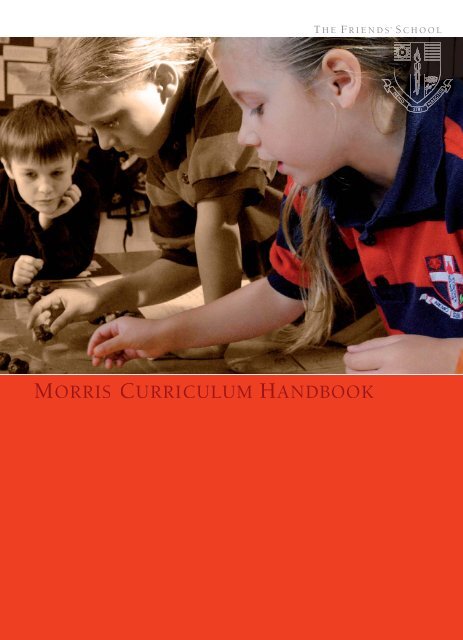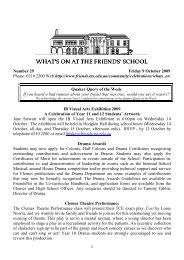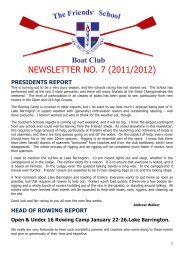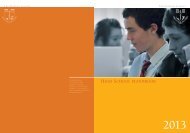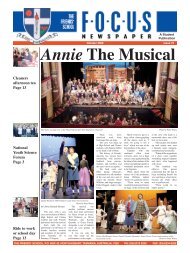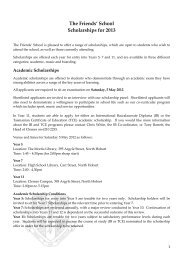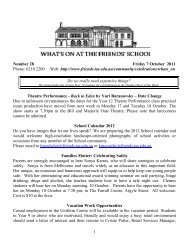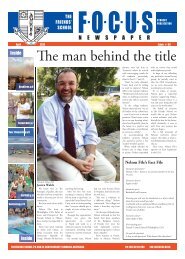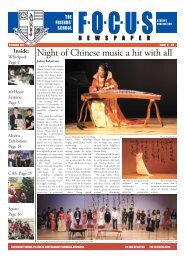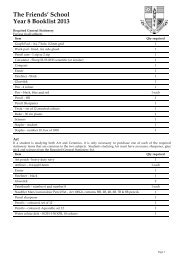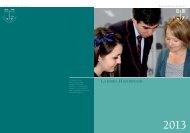MORRIS CURRICULUM HANDBOOK - The Friends' School
MORRIS CURRICULUM HANDBOOK - The Friends' School
MORRIS CURRICULUM HANDBOOK - The Friends' School
Create successful ePaper yourself
Turn your PDF publications into a flip-book with our unique Google optimized e-Paper software.
<strong>MORRIS</strong> <strong>CURRICULUM</strong> <strong>HANDBOOK</strong>T HE F RIENDS’ S CHOOL
THE FRIENDS’ SCHOOL<strong>MORRIS</strong> <strong>CURRICULUM</strong> <strong>HANDBOOK</strong><strong>The</strong> Friends’ <strong>School</strong> CRICOS Regn. 00477G
PURPOSE AND CONCERNS<strong>The</strong> Friends’ <strong>School</strong> is a co-educational Quaker school based on fundamental values such asthe intrinsic worth of each person, the recognition of ‘that of God’ in everyone, thedesirability of simplicity and the need to establish peace and justice.As a learning community, we are concerned for the academic, cultural, physical, social andspiritual development of each person in our care.We seek to help our students develop into men and women who will think clearly, act withintegrity, make decisions for themselves, be sensitive to the needs of others and theenvironment, be strong in service and hold a global perspective.We believe that these aims can best be achieved with the active support of all members of our<strong>School</strong> community.Morris Curriculum Handbook 2012i
THE MISSION STATEMENT OF THE INTERNATIONALBACCALAUREATE ORGANIZATION<strong>The</strong> International Baccalaureate Organization aims to develop enquiring, knowledgeableand caring young people to help create a better, more peaceful world through interculturalunderstanding and respect.To this end it works with schools, governments and international organizations to developchallenging programmes of international education and rigorous assessment.<strong>The</strong>se programmes encourage students across the world to become active, compassionate andlifelong learners who understand that other people, with their differences, can also be right.November 2002Morris Curriculum Handbook 2012ii
TABLE OF CONTENTSPURPOSE AND CONCERNS I!THE MISSION STATEMENT OF THE INTERNATIONAL BACCALAUREATEORGANIZATIONTABLE OF CONTENTSII!III!Introduction 1!Why has <strong>The</strong> Friends’ <strong>School</strong> chosen the PYP? 1!What do we want students to know? 1!Language 1!Mathematics 1!Social Studies – History and Geography 1!Science 2!<strong>The</strong> Arts 2!Personal, Social and Physical Education 2!How do we organise this knowledge? 3!What are the concepts and skills we want children to develop? 3!What attitudes and action do we want our children to develop? 4!How does this education equip our children for a future in the global community? 4!Expected Year Level Outcomes for Prep 8!English – Reading and Viewing 8!English – Writing 8!Mathematics 8!Expected Year Level Outcomes for Year 1 10!English – Reading and Viewing 10!English – Writing 10!Mathematics 10!Expected Year Level Outcomes for Year 2 12!English – Reading and Viewing 12!English – Writing 12!Mathematics 12!Expected Year Level Outcomes for Year 3 14!English – Reading and Viewing 14!English – Writing 14!Mathematics 14!Expected Year Level Outcomes for Year 4 16!English – Reading and Viewing 16!English – Writing 16!Mathematics 16Morris Curriculum Handbook 2012iii
Expected Year Level Outcomes for Year 5 18!English – Reading and Viewing 18!English – Writing 18!Mathematics 18!Expected Year Level Outcomes for Year 6 20!English – Reading and Viewing 20!English – Writing 20!Mathematics 20!Exhibition 21!Morris Curriculum Handbook 2012iv
INTRODUCTIONAt Morris, the International Baccalaureate Primary Years Programme (IB PYP) is the curriculum for allchildren from Kinder to Year 6. It focuses on the development of the whole child, offering a framework tomeet the academic, cultural, physical, social and spiritual development of each person.At the heart of the PYP is structured, purposeful inquiry that actively engages children. <strong>The</strong> starting point isthe student’s current understanding and the goal is the students turning what they have experienced intonew thinking. Students are encouraged to share responsibility for their own learning. We aim to elicit ideasof global significance that affect all people and that will help students see their place in the wider world.<strong>The</strong> approach is used in all areas of learning. Classroom and specialist teachers work together to plan richprograms, some parts of which are taught separately and others of which are taught in a more integratedway.WHY HAS THE FRIENDS’ SCHOOL CHOSEN THE PYP?• It is consistent with our Purpose and Concerns and aims to develop students who are global citizens.• It encourages children to integrate ideas and make connections across traditional subject areas.• It uses internationally recognised standards as the basis for curriculum design and implementation.• <strong>The</strong> programme and teaching are audited against internationally established benchmarks.• It has strong links to the emerging Australian Curriculum.WHAT DO WE WANT STUDENTS TO KNOW?At Morris there are six major learning areas:LanguageAs well as English, children explore the Japanese language and culture. We share a strong belief that eachstudent should have the opportunity to learn language, learn about language and learn through language.English is learned in a variety of contexts in every classroom. <strong>The</strong>re are times each week when children workin small groups where specific skills are targeted according to children’s current level of understanding andneed. This is particularly evident in reading and spelling. While aspects of the English program are taughtseparately from the programme of inquiry, frequently there are direct connections and opportunities toacquire, practice and demonstrate language skills during these inquiries.<strong>The</strong> Japanese program reflects the natural language learning sequence and is therefore primarily focused onspeaking and listening for authentic social purposes. Exploring Japanese culture and role playing are a majorpart of what children do during their Japanese lessons.MathematicsNumber work is frequently introduced and developed separately during focused Mathematics sessions.Wherever there is a natural connection, however, elements of the Maths program are learned or reinforcedwithin the contexts provided by the programme of inquiry. Data and statistics, measurement and aspects ofspace often lend themselves to authentic integration.Social Studies – History and GeographyAll of the History and Geography curriculum is incorporated into the programme of inquiry, and often sitsin the Where we are in time and place, Who we are, and How we organise ourselves units.Morris Curriculum Handbook 1
ScienceSimilarly, all of the Science curriculum sits within the programme of inquiry. <strong>The</strong> knowledge and skills ofScience are addressed mostly in the How the world works, Sharing the planet, and How we organise ourselvesunits.<strong>The</strong> ArtsFrom Kinder, children attend specialist Music classes each week, and from Year 1 specialist Art classes.Drama is incorporated into the English program. Classroom teachers also incorporate opportunities forchildren to further develop art and music into their classroom programs.Personal, Social and Physical EducationAll children participate in a specialist PE program either in two half hour sessions or for one hour eachweek. In addition the Year 6 PE leaders run short physical activity sessions for the early childhood classestwo mornings each week. <strong>The</strong> personal and social development program is core to our values, and allteachers share responsibility for this aspect of children’s learning. <strong>The</strong> Who we are units have a particularlystrong focus on this area.Morris Curriculum Handbook 2
HOW DO WE ORGANISE THIS KNOWLEDGE?To ensure that we offer a balanced curriculum and to encourage links across the curriculum, much of thisknowledge is organised into six transdisciplinary themes. Aspects of all six themes are explored in a unit ofinquiry in every year group.<strong>The</strong> six transdisciplinary themes investigate:• Who we are - An inquiry into the nature of the self; beliefs and values; personal, physical, mental, socialand spiritual health; human relationships including families, friends, communities, and cultures; rightsand responsibilities; what it means to be human.• Where we are in time and place - An inquiry into orientation in place and time; personal histories; homesand journeys; the discoveries, explorations and migrations of humankind; the relationships between andthe interconnectedness of individuals and civilisations, from local and global perspectives.• How we express ourselves - An inquiry into the ways in which we discover and express ideas, feelings,nature, culture, beliefs and values; the ways in which we reflect on, extend and enjoy our creativity; ourappreciation of the aesthetic.• How the world works - An inquiry into the natural world and its laws; the interaction between the naturalworld (physical and biological) and human societies; how humans use their understanding of scientificprinciples; the impact of scientific and technological advances on society and on the environment.• Sharing the planet - An inquiry into rights and responsibilities in the struggle to share finite resources withother people and with other living things; communities and the relationships within and between them;access to equal opportunities; peace and conflict resolution.• How we organise ourselves - An inquiry into the interconnectedness of human-made systems andcommunities; the structure and function of organisations; societal decision-making; economic activitiesand their impact on humankind and the environment.What are the concepts and skills we want children to develop?Each year, as children explore different subject matter they regularly revisit eight key questions. <strong>The</strong>seconceptual questions help them to focus their inquiries and also to make connections across subjects andyear levels.What is it like? (Form)How does it work? (Function)How is it changing? (Change)Why is it like this? (Causation)How is it connected to other things? (Connection)What are the points of view? (Perspective)What is our responsibility? (Responsibility)How do we know? (Reflection)Through their work, children acquire and apply a range of skills in communication, self-management,research, thinking and getting along with others. <strong>The</strong> progressive development of these essential skills isexplicitly planned for and taught at each year level.Morris Curriculum Handbook 3
What attitudes and action do we want our children to develop?We want children at Morris to be tolerant, creative, curious, appreciative, enthusiastic, confident, respectful,committed, co-operative, independent, and to be people of integrity and empathy. Children and teachersdeliberately reflect on the development of these attitudes during class, gatherings and in the playground.In addition to developing knowledge, concepts, skills and attitudes, we want children to take thoughtful andappropriate action. We offer all learners the opportunity and power to choose their actions, to act and toreflect on these actions in order to make a difference to the world.Children take action in many forms both at <strong>School</strong> and at home. <strong>The</strong>se actions range from sharing resourcesthey find, inviting parents and other guests to contribute their expertise, conducting independent inquiriesand sharing their findings, reaching out to others within the class and <strong>School</strong>, making environmentallyresponsible changes at <strong>School</strong> and at home, through to initiating, promoting and supporting a wide range ofservice activities within the school and wider community.How does this education equip our children for a future in the global community?At Morris you will see a strong focus on developing the values that will enable our students to think clearly,act with integrity, make decisions for themselves, be sensitive to the needs of others and the environment, bestrong in service and hold a global perspective. <strong>The</strong> IB Learner Profile provides us with a common languagefor inspiring, motivating and teaching our children. Reflection on ongoing development of these attributesoccurs regularly in all parts of the programme and provides a foundation for ongoing global citizenship.ProfileInquirersWhat can we see our children doing as they build on these qualities?<strong>The</strong>y develop their natural curiosity. <strong>The</strong>y acquire the skills necessary to conduct inquiryand research and show independence in learning. <strong>The</strong>y actively enjoy learning and thislove of learning will be sustained throughout their livesPrincipled<strong>The</strong>y act with integrity and honesty, with a strong sense of fairness, justice and respectfor the dignity of individuals, groups and communities. <strong>The</strong>y take responsibility for theirown actions and the consequences that accompany them.Thinkers<strong>The</strong>y exercise initiative in applying thinking skills critically and creatively to recogniseand approach complex problems, and make reasoned, ethical decisions.Communicators<strong>The</strong>y understand and express ideas and information confidently and creatively in morethan one language and in a variety of modes of communication. <strong>The</strong>y work effectivelyand willingly in collaboration with others.Caring<strong>The</strong>y show empathy, compassion and respect towards the needs and feelings of others.<strong>The</strong>y have a personal commitment to service, and act to make a positive difference to thelives of others and to the environment.BalancedKnowledgeable<strong>The</strong>y understand the importance of intellectual, physical and emotional balance toachieve personal well-being for themselves and others.<strong>The</strong>y explore concepts, ideas and issues that have local and global significance. In sodoing, they acquire in-depth knowledge and develop understanding across a broad andbalanced range of disciplines.Open-minded<strong>The</strong>y understand and appreciate their own cultures and personal histories, and are opento the perspectives, values and traditions of other individuals and communities. <strong>The</strong>y areMorris Curriculum Handbook 4
accustomed to seeking and evaluating a range of points of view, and are willing to growfrom the experience.Risk-takers<strong>The</strong>y approach unfamiliar situations and uncertainty with courage and forethought, andhave the independence of spirit to explore new roles, ideas and strategies. <strong>The</strong>y are braveand articulate in defending their beliefs.Reflective<strong>The</strong>y give thoughtful consideration to their own learning and experience. <strong>The</strong>y are ableto assess and understand their strengths and limitations in order to support their learningand personal development.In the appendix that follows, each year level’s programme of inquiry is presented, along with an outline ofthe year level expectations for English and Mathematics. While most children will achieve these year levelexpectations in the year presented, it is essential to recognise that, like learning to walk, learning to read andwrite and operate with numbers is developmental, and happens at different rates and times for eachindividual. Consequently, some children will take longer to acquire or consolidate particular knowledge andskills, while others will acquire them more quickly. <strong>The</strong> <strong>School</strong>’s open-ended, inquiry approach to learningassists teachers with modifying the programme to cater for these differences.In addition to these classroom programs there is a rich and varied co-curricular program offered at Morris,mainly for students from Year 2 onwards. <strong>The</strong> co-curricular program varies from year to year, depending onparent and staff availability and student interest. Programs are offered in the areas of creativity, action andservice and are optional. <strong>The</strong> music and sport components of these are particularly strong. <strong>The</strong> co-curricularprogram is offered before school, during breaks and after school and is explained in more detail in theMorris Annual Handbook.Morris Curriculum Handbook 5
Appendix – Morris Program of Inquiry, Year Level Expectations in English and Maths.WHO WE AREWHERE ARE WE IN TIMEAND PLACEHOW WE EXPRESSOURSELVESHOW THE WORLDWORKSSHARING THE PLANETHOW WE ORGANISEOURSELVESCENTRAL IDEA:I am an individual and I am partof a community.CENTRAL IDEA:<strong>The</strong> food we eat and sharereflects our personal tastesand backgroundsCENTRAL IDEA:People can work by themselvesand with others to explore andexpress ideas through drama.CENTRAL IDEA:Water is a naturalresource and is essentialto all living things.CENTRAL IDEA:When ecosystems are not inbalance living things can beat risk.CENTRAL IDEA:We use systems toorganise ourselves andshare responsibilities.KINDER(in each yearonly four ofthese areundertaken)AN INQUIRY INTO:Characteristics that make ussimilar, different and uniquePersonal histories andtimelinesFamilies including theirstructures and culturalbackgroundsAN INQUIRY INTO:Ways people share foodWhat people eat in differentplaces<strong>The</strong> food we can grow in agardenAN INQUIRY INTO:Real and imaginary characters<strong>The</strong> use of mime, movement andvoice to express feelings<strong>The</strong> use of costume, props andmovement to create character<strong>The</strong> creation and use ofperformance spaceAN INQUIRY INTO:Properties and states ofwater<strong>The</strong> water cycleHow water is usedWater conservationAN INQUIRY INTO:How native living thingsdepend on each other forsurvivalEnvironments that arebalanced and unbalancedHow we care for ourenvironmentAN INQUIRY INTO:How school is organised tohelp us learn and playtogetherHow we prepare ourselvesfor school each dayWhat we are responsiblefor in KindergartenHow we work together to bepart of a communityCONCEPTS:CONCEPTS:CONCEPTS:CONCEPTS:CONCEPTS:CONCEPTS:Connection, FormPerspective, ConnectionChange, ReflectionFunction, ResponsibilityCausation, ConnectionFunction, ResponsibilityRELATED CONCEPTS:Family, culture, individuality,time, similarities/differencesRELATED CONCEPTS:Choice, culture, place,preference, community,needs, growthRELATED CONCEPTS:Performance, expression,emotion, role playRELATED CONCEPTS:Cycles, properties,freezing, melting, wasteRELATED CONCEPTS:Needs, interdependence,balanceRELATED CONCEPTS:Organisation, roles,sharing, work<strong>The</strong> Kinder program is strongly play-based and responsive to the developmental needs of each individual child. A significant focus is placed on interpersonal, socialand communication skills rather than on an explicit academic program. <strong>The</strong> Kinder program is informed by both the PYP and the Australian Early Years framework.Morris Curriculum Handbook 6
WHO WE AREWHERE ARE WE IN TIMEAND PLACEHOW WE EXPRESSOURSELVESHOW THE WORLDWORKSSHARING THE PLANETHOW WE ORGANISEOURSELVESCENTRAL IDEA:CENTRAL IDEA:CENTRAL IDEA:CENTRAL IDEA:CENTRAL IDEA:CENTRAL IDEA:Through our senses wecollect information aboutthe world around us.Children everywhere andthrough time have playedgames.We can all respond to andproduce art in differentways for differentpurposes.We can experiment withmaterials and shapes toexplore their propertiesand what they can be usedfor.People and animals adaptto environments to survive.<strong>The</strong> products from animalsand crops help us ineveryday life.PREPAN INQUIRY INTO:What are the sensesHow we use our sensesWhat happens when asense doesn’t workAN INQUIRY INTO:<strong>The</strong> diversity of gamesHow games workSimilarities and changes ingames over timeAN INQUIRY INTO:How people expressthemselves through artWays of responding to artHow art can evokedifferent feelingsAN INQUIRY INTO:Properties of materialsWays in which propertiesor states of materials canbe changedWays in which the shapeand size of objects effectstheir movementAN INQUIRY INTO:Ways in which living thingsadapt to survive in differentenvironments.Similarities and differencesin adaptations.How the relationshipsbetween living things effecttheir survival.AN INQUIRY INTO:<strong>The</strong> types of animals foundon farms and the productsthey give us<strong>The</strong> types of crops grownon farms and the productsof those crops<strong>The</strong> line of production fromfarm-factory-shopCONCEPTS:Form, FunctionCONCEPTS:Function, ChangeCONCEPTS:Form, Perspective,ReflectionCONCEPTS:Change, FunctionCONCEPTS:Change, CausationCONCEPTS:Form, ConnectionRELATED CONCEPTS:Observation, exploration,diversity.RELATED CONCEPTS:Co-operation, similarities,differences, rules,continuity and changeRELATED CONCEPTS:Communication,inspiration, audience,observation, opinion,culture.RELATED CONCEPTS:Transformation, properties,movement, sequence,heating/cooling, mixtureRELATED CONCEPTS:Similarities/differences,adaptation, geography,interaction, hibernation,migrationRELATED CONCEPTS:Production, co-operation,transportation,employment, placeMorris Curriculum Handbook 7
EXPECTED YEAR LEVEL OUTCOMES FOR PREPEnglish – Reading and ViewingBy the end of Prep, children recognise several types of print texts and identify the purposes of some familiar texts. <strong>The</strong>y navigate a simple picture book or digital textusing knowledge of basic concepts about print. <strong>The</strong>y can discuss how factual texts differ from imaginative texts. Prep children recognise and name most letters of thealphabet and name sound–letter matches for most consonants and short vowels. <strong>The</strong>y recognise high frequency sight words and work out short regular words usingcontext, grammatical and phonic knowledge. <strong>The</strong>y read aloud short, predictable texts with some fluency and demonstrate early reading strategies such as re-reading tomaintain meaning. <strong>The</strong>y are able to re-tell one or two events in a story or a film, and discuss events and characters. <strong>The</strong>y relate one or two facts from an informationtext.English – WritingBy the end of Prep, children continue to engage in drawing, sketching and diagramming which are important parts of early writing as students emulate, rehearse andthink about the process of writing. <strong>The</strong>y write their name and other personally significant words and accurately write some high frequency words. <strong>The</strong>y assignmeaning to messages and gradually produce recognisable spellings of a range of words. <strong>The</strong>y recognise the names of most letters, give appropriate sounds for mostletters, realise that some letters make more than one sound and identify final and middle sounds in words. <strong>The</strong>y are willing to have a go, sound out words whilstwriting, begin to use some simple common letter patterns and use examples of print in their environment to check the spelling of words. <strong>The</strong>y write confidently withdeveloping legibility and fluency, and leave spaces between words. Children write for a variety of purposes and develop an understanding of different text forms.MathematicsBy the end of the Prep year, students make connections between number names, numerals and quantities up to 10. <strong>The</strong>y compare objects using mass, length andcapacity. Students connect events and the days of the week. <strong>The</strong>y explain the order and duration of events. <strong>The</strong>y use appropriate language to describe location.Students count to and from 20 and order small collections. <strong>The</strong>y group objects based on common characteristics and sort shapes and objects. Students answer simplequestions to collect information.Morris Curriculum Handbook 8
WHO WE AREWHERE ARE WE IN TIMEHOW WE EXPRESSHOW THE WORLDSHARING THE PLANETHOW WE ORGANISEAND PLACEOURSELVESWORKSOURSELVESCENTRAL IDEA:CENTRAL IDEA:CENTRAL IDEA:CENTRAL IDEA:CENTRAL IDEA:CENTRAL IDEA:Being a friend and developingThings we find today, bothCelebrations bring peopleScience helps explainEnvironments are effectedTransport is designed to meetfriendships help us tolocally and globally, can helptogether to share events thatobservable behavioursby human activities.the needs of people.understand others and work wellus understand the past.are important to them.and help with design.together.YEAR 1AN INQUIRY INTO:Common characteristics of aAN INQUIRY INTO:How the world has changedAN INQUIRY INTO:Events people celebrate andAN INQUIRY INTO:Properties of air thatAN INQUIRY INTO:<strong>The</strong> characteristics ofAN INQUIRY INTO:Why transport systems aregood friendHow friends are made and keptCharacteristics and behaviourthat develop healthy friendshipsManaging and resolving conflict<strong>The</strong> process of extinction<strong>The</strong> role of artefacts in findingout about the pastwhy they doHow people celebrate theseeventsHow similar events may becelebrated differentlysupport flightFlight in natureHow we have mademachines that flydifferent freshwaterenvironments<strong>The</strong> interdependence ofmembers of each particularenvironment<strong>The</strong> impact of human societyorganised in our community.How communities are assistedin their daily life by theorganization of the transportsystem/s<strong>The</strong> influences that impact onon freshwater environments.the design of transport systemsin other countries.CONCEPTS:CONCEPTS:CONCEPTS:CONCEPTS:CONCEPTS:CONCEPTS:Connection, ResponsibilityChange, ReflectionConnection, PerspectiveForm, Function,Connection, ResponsibilityForm, FunctionCausationRELATED CONCEPTS:RELATED CONCEPTS:RELATED CONCEPTS:RELATED CONCEPTS:RELATED CONCEPTS:Conflict, co-operation,Archaeology, artefacts,Tradition, family,RELATED CONCEPTS:Interdependence, impact,Isolation, dependence, needs,communicationpalaeontology, interpretationcommemoration, continuityObservation, prediction,degradation, rehabilitationorganisation, systemsand changebehaviour, flight,movementMorris Curriculum Handbook 9
EXPECTED YEAR LEVEL OUTCOMES FOR YEAR 1English – Reading and ViewingBy the end of Year 1, children identify a book's purpose using information from the cover and illustrations in the book. <strong>The</strong>y navigate different types of print anddigital texts and read simply-structured narrative and information texts and recall significant information and ideas. <strong>The</strong>y participate in discussions about text content,plot, characters and setting and retell stories. <strong>The</strong>y make simple inferences about ideas, characters and events and identify words and images that represent people,things and actions. Children read aloud simple texts with extended sentence patterns, responding appropriately to sentence boundary punctuation. <strong>The</strong>y use context,grammatical and phonic knowledge to predict and confirm as they read and to work out unfamiliar words, including words containing learned digraphs (two touchingvowels) and blends (touching consonants).English – WritingChildren in Year 1 write confidently with increasing legibility and fluency. <strong>The</strong>y write for a variety of purposes and begin to develop an understanding of different textforms. <strong>The</strong>y produce a small range of texts that exhibit some of the conventions of that text form and begin to describe and justify some of the choices they have madeas a writer. <strong>The</strong>y begin to plan and edit their own writing. <strong>The</strong>y write some high frequency words accurately, know some subject specific words, are willing to have ago and correct mis-spelt words when the teacher has identified the word. <strong>The</strong>y articulate the strategies they use for spelling unfamiliar words. <strong>The</strong>y orally break wordsinto syllables by clapping, identify and use knowledge of similar sounding words, recognise and use letter patterns and refer to resources for correct spelling. <strong>The</strong>yknow all sounds made by a single letter, use initial consonant blends and understand that vowels have at least two sounds. <strong>The</strong>y orally identify and represent inwriting all sounds in one and two syllable words including vowel sounds.MathematicsBy the end of Year 1, students describe number sequences resulting from skip counting by 2s, 5s and 10s. <strong>The</strong>y identify representations of one half. <strong>The</strong>y recogniseAustralian coins according to their value. Students explain time durations. <strong>The</strong>y describe two-dimensional shapes and three-dimensional objects. Students describedata displays.Students count to and from 100 and locate numbers on a number line. <strong>The</strong>y carry out simple additions and subtractions using counting strategies. <strong>The</strong>y break upnumbers using place value. <strong>The</strong>y continue simple patterns involving numbers and objects. Students order objects based on lengths and capacities using informal units.<strong>The</strong>y tell time to the half hour. <strong>The</strong>y use the language of direction to move from place to place. Students classify outcomes of simple familiar events. <strong>The</strong>y collect databy asking questions and draw simple data displays.Morris Curriculum Handbook 10
WHO WE AREWHERE ARE WE INHOW WE EXPRESSHOW THE WORLD WORKS SHARING THE PLANET HOW WE ORGANISETIME AND PLACEOURSELVESOURSELVESCENTRAL IDEA:CENTRAL IDEA:CENTRAL IDEA:CENTRAL IDEA:CENTRAL IDEA:CENTRAL IDEA:Characters in literature help usPlaces and how peopleCulture can be explored andLiving things have characteristicsHow we choose to consumePeople use systems of trade toto understand characteristicsuse them change overexpressed through the arts.and features that enable them toresources and reduce wasteaccess a range of goods andand behaviours in ourselves andtime.live successfully in theireffects the environment.services to meet their needs andothers.environment.wants.YEAR 2AN INQUIRY INTO:<strong>The</strong> attributes characters inAN INQUIRY INTO:How places changeAN INQUIRY INTO:What culture isAN INQUIRY INTO:What an invertebrate isAN INQUIRY INTO:<strong>The</strong> resources of our worldAN INQUIRY INTO:Different kinds of shops andliterature show us through theirstories and actionsover timeHow people use theseHow we express our culturethrough the arts<strong>The</strong> relationships between thefeatures of invertebrates and howand how we consume them.Reducing, Reusing, RecyclingservicesHow shops operateHow connections made tostories help readers understandthemselves and each other.placesWhat has changed inthese placesHow indigenous peopleexpress their culture throughthe artsthey meet their needsChanges which take place in thecourse of the life span of livingand Rethinking ourconsumption of resources.How shops attract customers<strong>The</strong> function and value of moneyHow reflection on new learningthingshelps us grow as individuals.How reflection on new learninghelps us understand others.CONCEPTS:CONCEPTS:CONCEPTS:CONCEPTS:CONCEPTS:CONCEPTS:Perspective, ReflectionChange, CausationForm, ConnectionForm, Change, CausationReflection, ResponsibilityFunction, FormRELATED CONCEPTS:RELATEDRELATED CONCEPTS:RELATED CONCEPTS:RELATED CONCEPTS:RELATED CONCEPTS:Empathy, self-knowledge,CONCEPTS:Culture, story, tradition,Classification, lifecycles, needs,Choice, waste, finite/infinite,Value, trade, advertising, needsmetacognitionLocation, work, place,artefactscharacteristicsconsumption, materialsartefacts, mappingMorris Curriculum Handbook 11
EXPECTED YEAR LEVEL OUTCOMES FOR YEAR 2English – Reading and ViewingBy the end of Year 2, children read a range of books to develop knowledge of authors, illustrators and their own reading preferences. Students select books to suitdifferent purposes. <strong>The</strong>y use the title, table of contents, headings and sub-headings, indexes, glossaries and screen conventions to navigate and use texts. <strong>The</strong>y read andview longer narrative and information texts, discussing possible meanings and predicting likely future events. <strong>The</strong>y use texts with some complex language, ideas andvocabulary to find information on a range of topic areas. <strong>The</strong>y identify literal information in texts and begin to make inferences about characters' actions andmotivations. <strong>The</strong>y relate information, ideas and events in texts to their own lives and to other texts. Year 2 children demonstrate knowledge of most common irregularwords and use morphemes (units of meaning eg magic in magician) and syllabification to read some simple multi-syllabic words. Following the opportunity torehearse, they read aloud with fluency and intonation and self-correct using context, prior knowledge, grammatical and phonic knowledge.English – WritingYear 2 students write increasingly independently and with confidence. <strong>The</strong>y begin to use a wide and vivid vocabulary with supporting details. <strong>The</strong>y developunderstanding that different types of writing have different structures and are able to describe and justify some of the choices they have made as a writer. <strong>The</strong>y chooseto write for a variety of purposes, both creative and informational and plan, edit and begin to review their own writing. <strong>The</strong>y have an increasing knowledge of spellinggeneralisations including some of the rules for silent final e, sounds never found at the end of English words and doubling the consonants l,f and s. <strong>The</strong>y recognisecompound words and know some common homophones (eg to, too, two). <strong>The</strong>y use final consonant blends, common two digit letter patterns, y on the end of words,simple suffixes and contractions. <strong>The</strong>y use known simple words to derive new words, identify the sound of each syllable, use an extending bank of high frequencywords, and know some subject specific words. <strong>The</strong>y sound out and check visually, and use known letter patterns to invent. <strong>The</strong>y identify and self correct some wordsindependently and can use a simple dictionary or glossary to check the spelling of a word.MathematicsBy the end of Year 2, students recognise increasing and decreasing number sequences involving 2s, 3s and 5s. <strong>The</strong>y represent multiplication and division by groupinginto sets. <strong>The</strong>y associate collections of Australian coins with their value. Students identify the missing element in a number sequence. Students recognise the features ofthree-dimensional objects. <strong>The</strong>y interpret simple maps of familiar locations. <strong>The</strong>y explain the effects of one-step transformations (flip or slide or turn). Students makesense of collected information.Students count to and from 1,000. <strong>The</strong>y perform simple addition and subtraction calculations using a range of strategies. <strong>The</strong>y divide collections and shapes into halves,quarters and eighths. Students order shapes and objects using informal units. <strong>The</strong>y tell time to the quarter hour and use a calendar to identify the date and the monthsincluded in seasons. <strong>The</strong>y draw two-dimensional shapes. <strong>The</strong>y describe outcomes for everyday events. Students collect data from relevant questions to create lists,tables and picture graphs.Morris Curriculum Handbook 12
WHO WE AREWHERE ARE WE IN TIMEAND PLACEHOW WE EXPRESSOURSELVESHOW THE WORLDWORKSSHARING THE PLANETHOW WE ORGANISEOURSELVESCENTRAL IDEA:Humans are primates whoshare many characteristicswith other primates, buthave some uniquecharacteristics of their own.CENTRAL IDEA:People everywhere andthroughout time havealways wondered aboutthe Earth’s place in space.CENTRAL IDEA:People influence us indifferent ways when theyexpress their gifts andtalents.CENTRAL IDEA:People use machines inorder to do things moreefficiently and effectively.CENTRAL IDEA:Over time and in differentenvironments, plants adaptin order to survive.CENTRAL IDEA:We live in a globalcommunity and throughcommunication technologywe can share informationand learn from each other.YEAR 3AN INQUIRY INTO:What primates arePhysical similarities anddifferences betweenhumans and other primatesBehavioural similarities anddifferences betweenhumans and other primates<strong>The</strong> social organisation ofhumans compared to thatof other, higher orderprimates.AN INQUIRY INTO:Our place in spacePast present and futurehuman exploration ofspaceHow space phenomenahave been explainedthrough myths andlegendsAN INQUIRY INTO:Role models and why wevalue them<strong>The</strong> various ways in whichpeople can be influencedby their role models.<strong>The</strong> different ways inwhich people expressthemselves and theirideas.AN INQUIRY INTO:Simple machines<strong>The</strong> ways in which simplemachines are used<strong>The</strong> impact simplemachines have had onsocietyAN INQUIRY INTO:<strong>The</strong> structure, function andneeds of plantsHow plants survive indifferent environmentsHuman dependence onplantsAN INQUIRY INTO:<strong>The</strong> development ofcommunication technologiesover time.How connections can bemade using communicationtechnology.CONCEPTS:Causation, Change,ReflectionCONCEPTS:Perspective, Connection,ReflectionCONCEPTS:Form, Function,ConnectionCONCEPTS:Function, Causation,PerspectiveCONCEPTS:Function, Connection,ResponsibilityCONCEPTS:Change. ConnectionRELATED CONCEPTS:Similarities/differences,behavior, classification,relationshipRELATED CONCEPTS:Space, discovery,wondering, revelation,light, scaleRELATED CONCEPTS:Individuality, values,qualitiesRELATED CONCEPTS:Mechanics, efficiency,designRELATED CONCEPTS:Growth, reproduction,adaptation, habitat,living/non-living/once livingRELATED CONCEPTS:Time, innovation,relationships,communicationMorris Curriculum Handbook 13
EXPECTED YEAR LEVEL OUTCOMES FOR YEAR 3English – Reading and ViewingBy the end of Year 3, students read, view, navigate and respond to a range of print and other texts (including audio visual and multi-media texts) with familiarstructures, and read aloud with clarity and expression. <strong>The</strong>y retell the main ideas in texts in logical sequence, and identify themes and experiences in literary texts. <strong>The</strong>yaccurately locate literal information and make informed inferences about ideas in texts, referring to print and visual information. <strong>The</strong>y use word attack strategies,monitor their own reading, and self-correct to maintain meaning. Children in Year 3 use a range of appropriate strategies to justify their predictions and interpretationsof ideas and information. <strong>The</strong>y clarify meaning by making relevant connections between visual and written elements in texts, and draw conclusions by interpreting andintegrating ideas and information. <strong>The</strong>y express relevant ideas and opinions on texts, and refer to specific evidence and detail to support these opinions. <strong>The</strong>y identifysimple literary devices used by authors. <strong>The</strong>y make effective use of organisational features of texts, library skills, and bookmarked websites to access specificinformation.English – WritingBy the end of Year 3, children develop fluency in writing and write independently and with confidence using a wide and vivid vocabulary with supporting details.<strong>The</strong>y demonstrate understanding that different types of writing have different structures. <strong>The</strong>y describe and justifying the choices they have made as a writer and writefor a variety of purposes and audiences. Year 3 children plan, edit and review their own writing with increasing independence and understand the importance ofcorrect spelling. <strong>The</strong>y have an extended bank of high frequency words, know some subject specific words, and proof read their own writing, identify visually incorrectletter patterns and attempt to correct misspelt words with teacher direction. <strong>The</strong>y break words into syllables and represent all vowels and consonant sounds in a word,placing vowels in every syllable. <strong>The</strong>y know and can represent correctly most sounds and use most letter patterns, double letters and the rules for final silent e. <strong>The</strong>yuse compound words, common homophones and an increasing number of suffixes correctly including when adding to words ending in y, and contractions where theapostrophe replaces one letter. <strong>The</strong>y identify base words and add prefixes to create new words. <strong>The</strong>y use both phonetic and visual strategies to spell unfamiliar words.MathematicsBy the end of Year 3, students recognise the connection between addition and subtraction and solve problems using efficient strategies including for simplemultiplication. <strong>The</strong>y model and represent unit fractions. <strong>The</strong>y represent money values in various ways. Students identify symmetry in the environment. <strong>The</strong>y matchpositions on maps with given information. Students recognise angles in real situations. <strong>The</strong>y interpret and compare data displays.Students count to and from 10,000. <strong>The</strong>y classify numbers as either odd or even. <strong>The</strong>y recall addition and subtraction facts, and multiplication and related division factsfor x2, x3, x5 and x10. Students correctly count out change from financial transactions. <strong>The</strong>y continue number patterns involving addition and subtraction. Students usemetric units for length, mass and capacity. <strong>The</strong>y tell time to the nearest minute. Students make models of three-dimensional objects. Students conduct chanceexperiments and list possible outcomes. <strong>The</strong>y carry out simple data investigations for categorical variables.Morris Curriculum Handbook 14
WHO WE AREWHERE ARE WE INHOW WE EXPRESSHOW THE WORLDSHARING THE PLANETHOW WE ORGANISETIME AND PLACEOURSELVESWORKSOURSELVESCENTRAL IDEA:CENTRAL IDEA:CENTRAL IDEA:CENTRAL IDEA:CENTRAL IDEA:CENTRAL IDEA:Using interpersonal andSettlement has had anFashions change overScientific understanding<strong>The</strong> use of fossil fuels isHuman exploration arisespersonal skills, humansimpact on local customstime and are reflectedhelps in the preservationaffecting our environment.from curiosity, political andbuild communityand cultures.through the creative arts.and management ofeconomic need, andresources.advances in technology.YEAR 4AN INQUIRY INTO:Respectful behaviours andAN INQUIRY INTO:Circumstances ofAN INQUIRY INTO:Factors that influenceAN INQUIRY INTO:<strong>The</strong> ocean as anAN INQUIRY INTO:<strong>The</strong> nature of fossil fuelsAN INQUIRY INTO:Causes and consequencesvaluing differencesConflict and conflictsettlementImmediate and long termdifferent styles in differenterasecosystem<strong>The</strong> potential impacts onHow fossil fuels areeffecting the environmentof great journeys ofexplorationresolutionAssertive behavioursimpacts of settlementLegacies of the settlers<strong>The</strong> differences inmaterials used over timeits balance<strong>The</strong> management ofEnergy use in ourcommunityHistorical processesCase study (Tasmania)<strong>The</strong> different ways inwhich materials have beenocean resourcesAlternative energy optionsusedCONCEPTS:CONCEPTS:CONCEPTS:CONCEPTS:CONCEPTS:CONCEPTS:Connection, PerspectiveCausation, PerspectiveChange, Function,Function, ResponsibilityForm, FunctionCausation, ReflectionConnectionRELATED CONCEPTS:RELATED CONCEPTS:RELATED CONCEPTS:RELATED CONCEPTS:RELATED CONCEPTS:RELATED CONCEPTS:Peace and conflict, respect,responsibility, values,Resources, geography,society, history, impactCreativity, expression,continuity and changeSystems, balance,measurement, data,Energy, power,consumption, pollution,Cause and effect, sources,significance, empathy,empathyresources, producers,cause and effect, heat,perspectiveconsumers, decomposerslightMorris Curriculum Handbook 15
EXPECTED YEAR LEVEL OUTCOMES FOR YEAR 4English – Reading and ViewingBy the end of Year 4, children read, view, navigate and respond to imaginative, informative and persuasive texts with some unfamiliar ideas and information. <strong>The</strong>yidentify the features and purposes of a range of different text types, including print and multimodal texts and evaluate the effectiveness of text design and how itcontributes to meaning. <strong>The</strong>y discuss the ways people, places and events are represented in texts, and provide plausible reasons for their opinions. <strong>The</strong>y identify keyideas, characters and events in texts and make relevant inferences about motives, actions, causes and consequences. <strong>The</strong>y use strategies such as predicting, drawing onprior knowledge, questioning, and making connections to interpret ideas and information. <strong>The</strong>y share judgments and preferences about texts, and respond to others'viewpoints. Year 4 students select relevant evidence from texts to explain cause and effect and suggest alternatives to others' opinions. <strong>The</strong>y locate texts for differentpurposes using relevant library and online search skills.English – WritingBy the end of Year 4, students write increasingly fluently and effectively for a wide range of purposes. <strong>The</strong>y understand that different types of writing have differentstyles and structures and are used for different purposes. <strong>The</strong>y show a growing awareness of audience. <strong>The</strong>y use relevant and appropriate supporting details, a rangeof effective vocabulary and a variety of sentence structures and sentence lengths. <strong>The</strong>y use writing processes with increasing independence and confidence: planning,drafting, conferring, refining and publishing their own writing. <strong>The</strong>y articulate the strategies they use for spelling unfamiliar words, recognise when a word doesn’tlook right and generate alternative spellings and use a dictionary to check spelling. <strong>The</strong>y use an increasing range of prefixes and suffixes, and know the rules forsyllabification and letter patterns with silent letters. <strong>The</strong>y use contractions where the apostrophe replaces more than one letter and apostrophe for possession.<strong>The</strong>y consider and act on the responses of others, gaining an awareness of themselves as authors, beginning to develop their own voice and style to personalise theirwriting. <strong>The</strong>y write for enjoyment and communication daily for sustained periods.MathematicsBy the end of Year 4, students choose appropriate strategies for calculations involving multiplication and division. <strong>The</strong>y recognise common equivalent fractions infamiliar contexts and make connections between fraction and decimal notations up to two decimal places. Students solve simple purchasing problems. <strong>The</strong>y identifyunknown quantities in number sentences. <strong>The</strong>y describe number patterns resulting from multiplication. Students compare areas of regular and irregular shapes usinginformal units. <strong>The</strong>y solve problems involving time duration. <strong>The</strong>y interpret information contained in maps. Students identify dependent and independent events.<strong>The</strong>y describe different methods for data collection and representation, and evaluate their effectiveness.Students use the properties of odd and even numbers. <strong>The</strong>y recall multiplication facts to 10 x 10 and related division facts. Students locate familiar fractions on anumber line. <strong>The</strong>y continue number sequences involving multiples of single digit numbers. Students use scaled instruments to measure temperatures, lengths, shapesand objects. <strong>The</strong>y convert between units of time. Students create symmetrical shapes and patterns. <strong>The</strong>y classify angles in relation to a right angle. Students list theprobabilities of everyday events. <strong>The</strong>y construct data displays from given or collected data.Morris Curriculum Handbook 16
WHO WE AREWHERE ARE WE INHOW WE EXPRESSHOW THE WORLDSHARING THE PLANETHOW WE ORGANISETIME AND PLACEOURSELVESWORKSOURSELVESCENTRAL IDEA:CENTRAL IDEA:CENTRAL IDEA:CENTRAL IDEA:CENTRAL IDEA:CENTRAL IDEA:<strong>The</strong> human body consistsPhysical geography plays<strong>The</strong> media is a powerfulChanges in both structureOrganisations have beenCommercial ventures needof interrelated systems thata major role in theway of influencingand atmosphere of theestablished in an effort toto consider theirneed our care and attentioncharacter and functioningpeople’s ideas andearth can lead to naturalmake our world a betterenvironmental impact toto function effectively.of communities.opinions.disasters.place.remain sustainable.YEAR 5AN INQUIRY INTO:Functions of the bodyAN INQUIRY INTO:Communities in our regionAN INQUIRY INTO:<strong>The</strong> role and power of theAN INQUIRY INTO:<strong>The</strong> structure of the EarthAN INQUIRY INTO:<strong>The</strong> role, functions andAN INQUIRY INTO:Positive and negativesystemsWhat we can do to promotehealthy functioning bodysystemsPrimary industryLifestylemedia in a global worldHow the media influencesour ideas and opinionsHow are different points ofview / text types /presented in the mediaand it’s atmosphere<strong>The</strong> causes and effects ofnatural disasters<strong>The</strong> role of science inunderstanding and makingpredictions about naturaldisasterscontributions of globalorganisations such as theUN, WWF, AmnestyInternational, MedicansSan FrontieresLocal organisations, theirmissions and work, andhow they strive for moreimpacts of a selectedindustrySustainable industryEco - industrypeaceful and equitablecommunitiesCONCEPTS:CONCEPTS:CONCEPTS:CONCEPTS:CONCEPTS:CONCEPTS:Change, ResponsibilityForm, CausationFunction, PerspectiveForm, Causation,Responsibility, ConnectionForm, Function,ReflectionResponsibilityRELATED CONCEPTS:RELATED CONCEPTS:RELATED CONCEPTS:RELATED CONCEPTS:RELATED CONCEPTS:RELATED CONCEPTS:Growth, health, risk,disease, life cycleLocality,Compare/contrast, naturalPersuasion, power,representation, bias,Solids, liquids, gases,tectonics, weather, climateEquity, peace, service,compassion, empathyBalance, adaptation,impact, commerce, survivalresources, work,mediaproductivityMorris Curriculum Handbook 17
EXPECTED YEAR LEVEL OUTCOMES FOR YEAR 5English – Reading and ViewingBy the end of Year 5, children read, view, navigate and respond to a range of literary, informative and persuasive texts in print and digital formats that present somecomplex ideas and themes. <strong>The</strong>y make appropriate links between text structures and language features and the context and purposes of texts. Children draw informedconclusions and make inferences based on literal and implied information. <strong>The</strong>y interpret, critique and synthesise ideas and information in texts, consistentlysupporting their responses with evidence from the text. <strong>The</strong>y recognise and describe how language choices and techniques influence audiences and identify ways inwhich their own and others’ interpretations of texts are shaped by individual values and experiences, and expand their own understanding by taking account ofdifferent opinions and interpretations. <strong>The</strong>y use a range of research strategies and resources effectively, and locate information on a topic from multiple sources, such asby previewing and reading selectively.English – WritingBy the end of Year 5, children write fluently and effectively for a wide range of purposes both creative and informational, using a range of styles. <strong>The</strong>y continue toexpand their repertoire of familiar text forms, and can discuss their different styles, structures and purposes. <strong>The</strong>y show clear awareness of audience. In their writingthey use relevant and appropriate supporting details, a wide range of effective vocabulary and a variety of sentence structures and sentence lengths. <strong>The</strong>y describe theirwriting processes confidently: planning, drafting, conferring, refining and publishing and consistently use these in their own writing. Children in year 5 independentlyproof read their own writing and attempt to correct mis-spelt words <strong>The</strong>y articulate the strategies they use for spelling unfamiliar words and these includesyllabification, letter patterns, high frequency words, base words and word origins. <strong>The</strong>y understand the concepts of a root word and use predominately visual andmeaning based strategies to spell unfamiliar words, as well as spelling references such as dictionaries, thesaurus, spell checker and resource books. <strong>The</strong>y consider andact on the responses of others, gain an awareness of themselves as authors, and develop their own voice and style to personalise their writing. <strong>The</strong>y continue to writefor enjoyment and communication for sustained periods, both in school and at home.MathematicsBy the end of Year 5, students solve simple problems involving the four operations using a range of strategies. <strong>The</strong>y check the reasonableness of answers usingestimation and rounding. Students identify and describe factors and multiples. <strong>The</strong>y explain plans for simple budgets. Students connect three-dimensional objects withtheir two-dimensional representations. <strong>The</strong>y describe transformations of two-dimensional shapes and identify line and rotational symmetry. Students compare andinterpret different data sets.Students order decimals and unit fractions and locate them on number lines. <strong>The</strong>y add and subtract fractions with the same denominator. Students continue patterns byadding and subtracting fractions and decimals. <strong>The</strong>y find unknown quantities in number sentences. <strong>The</strong>y use appropriate units of measurement for length, area,volume, capacity and mass, and calculate perimeter and area of rectangles. <strong>The</strong>y convert between 12 and 24-hour time. Students use a grid reference system to locatelandmarks. <strong>The</strong>y measure and construct different angles. Students list outcomes of chance experiments with equally likely outcomes and assign probabilities between 0and 1. Students pose questions to gather data, and construct data displays appropriate for the data.Morris Curriculum Handbook 18
WHO WE AREWHERE ARE WE INHOW WE EXPRESSHOW THE WORLDSHARING THE PLANETHOW WE ORGANISETIME AND PLACEOURSELVESWORKSOURSELVESCENTRAL IDEA:CENTRAL IDEA:CENTRAL IDEACENTRAL IDEA:CENTRAL IDEA:CENTRAL IDEA:People express their<strong>The</strong> formation of a countryCommunities are<strong>The</strong> innovative use ofEquitable access to naturalAll countries have a systemspirituality throughis the result of manyconnected through thescience and technologyresources is a challenge.of government.exploring and enactinginfluences and events.expression of culturallyhelps us to solvebeliefs and values.significant traditions.problems.YEAR 6AN INQUIRY INTO:AN INQUIRY INTO:AN INQUIRY INTO:AN INQUIRY INTO:AN INQUIRY INTO:AN INQUIRY INTO:(Five of these areundertaken each year,and the sixth isundertaken as theexhibition which maybe modified or rewritten)<strong>The</strong> role of religiousorganisations in societies<strong>The</strong> nature and function ofplaces of worshipSimilarities and differencesbetween spiritual practicesSignificant and defininginfluences and events inour national historyFactors that haveinfluenced our nationalidentitySignificant traditionsForms of expressionWays in whichcommunities connectProblem solving modelsand their application indesign<strong>The</strong> application of scienceand engineering principlesin effective problemsolutions<strong>The</strong> types of naturalresources.Human rights issues thatare associated with thesharing of naturalresources.Conflict and peacefulAustralian democracy andhow it worksOther systems ofgovernment and how theycompare with the Australiansystemresolutions over the accessto natural resources.CONCEPTS:CONCEPTS:CONCEPTS:CONCEPTS:CONCEPTS:CONCEPTS:Form, Perspective,Causation, ConnectionConnection, FormFunction, Causation,Form ChangeFunction, Causation,ReflectionReflectionResponsibility PerspectiveResponsibilityRELATED CONCEPTS:RELATED CONCEPTS:RELATED CONCEPTS:RELATED CONCEPTS:RELATED CONCEPTS:RELATED CONCEPTS:Spirituality, belief, tradition,ritual, diversityCulture, identity, conflict,migration, tradeCulture, community, ritesof passage, creativity, arts,traditionEngineering, forces,energy, electrical circuits,ingenuity, roboticsResources, materials,equity, scarcity,Democracy, law, power,government, decisionmakingMorris Curriculum Handbook 19
EXPECTED YEAR LEVEL OUTCOMES FOR YEAR 6English – Reading and ViewingBy the end of Year 6, children read, view, navigate and respond to a wide variety of literary, informative and persuasive texts that explore themes from differenthistorical, geographical and cultural contexts. <strong>The</strong>y use evidence from literary and informative texts to develop reasoned arguments on key ideas. <strong>The</strong>y use appropriatestrategies to synthesise and summarise information on a particular topic from several texts, and make accurate generalisations about the topic. Through close analysisof language and design elements, they critically evaluate and compare different perspectives presented in print and digital texts. Year 6 children identify and explainhow written information and visual images are integrated in texts to shape meaning and evaluate the structures and language features of texts selected to influenceaudiences to share a point of view. <strong>The</strong>y selectively source specific information using evaluative library and online research skills.English – WritingBy the end of Year 6, children write fluently and effectively for a wide range of purposes both creative and informational, using a range of styles. <strong>The</strong>y continue toexpand their repertoire of familiar text forms, and can discuss their different styles, structures and purposes. <strong>The</strong>y show clear awareness of audience, use relevant andappropriate supporting details, a wide range of effective vocabulary and a variety of sentence structures and sentence lengths. <strong>The</strong>y use increasingly sophisticatedlanguage and spell accurately a number of words with less common letter patterns. <strong>The</strong>y describe writing processes confidently: planning, drafting, conferring, refiningand publishing and consistently use these in their own writing. <strong>The</strong>y display a conscientious approach to editing and writing with correct spelling, drawing on a rangeof strategies to spell difficult and unfamiliar words. <strong>The</strong>y identify what they need to know to spell an unfamiliar word, use knowledge of root words to writeunfamiliar difficult words, and use a dictionary to find out word origins. <strong>The</strong>y consider and act on the responses of others, gain an awareness of themselves as authors,and develop their own voice and style to personalise their writing. <strong>The</strong>y continue to write for enjoyment and communication for sustained periods, both in school andat home.MathematicsBy the end of Year 6, students recognise the properties of prime, composite, square and triangular numbers. <strong>The</strong>y describe the use of integers in everyday contexts.<strong>The</strong>y solve problems involving all four operations with whole numbers. Students connect fractions, decimals and percentages as different representations of the samenumber. <strong>The</strong>y solve problems involving the addition and subtraction of related fractions. Students make connections between the powers of 10 and the multiplicationand division of decimals. <strong>The</strong>y describe rules used in sequences involving whole numbers, fractions and decimals. Students connect decimal representations to themetric system and choose appropriate units of measurement to perform a calculation. <strong>The</strong>y make connections between capacity and volume. <strong>The</strong>y solve problemsinvolving length and area. <strong>The</strong>y interpret timetables. Students describe combinations of transformations. <strong>The</strong>y solve problems using the properties of angles. Studentscompare observed and expected frequencies. <strong>The</strong>y interpret and compare a variety of data displays including those displays for two categorical variables. <strong>The</strong>yevaluate secondary data displayed in the media.Students locate fractions and integers on a number line. <strong>The</strong>y calculate a simple fraction of a quantity. <strong>The</strong>y add, subtract and multiply decimals and divide decimalswhere the result is rational. Students calculate common percentage discounts on sale items. <strong>The</strong>y write correct number sentences using brackets and order ofoperations. Students locate an ordered pair in any one of the four quadrants on the Cartesian plane. <strong>The</strong>y construct simple prisms and pyramids. Students list andcommunicate probabilities using simple fractions, decimals and percentages.Morris Curriculum Handbook 20
ExhibitionTowards the end of Year 6, students engage in an in-depth, collaborative inquiry. <strong>The</strong>y demonstrate independence and responsibility for their own learning andexplore multiple perspectives. <strong>The</strong>y exhibit ongoing development of the attributes of the learner profile. <strong>The</strong>y demonstrate engagement with the five essential elementsof the program: knowledge, concepts, skills, attitudes and action. <strong>The</strong>y synthesise and apply their learning of previous years, and reflect on their journey through thePYP.Morris Curriculum Handbook 21


